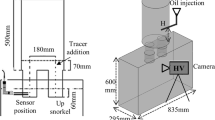Abstract
The circulation rate of steel is known to play a vital role in the superlative performance of the Ruhrstahl–Heraeus (RH) degasser. Numerous experiments were conducted on a physical model for the RH degassing process, which was established at IEHK, RWTH-Aachen University. The model was developed with a scale ratio of 1:3 to study the RH process. This study is conducted to show the effects of operational and nonoperational parameters on the circulation rate of liquid water in the model. The effects of lift gas flow rate, submerged depth of snorkels, water level in vessel, etc. on the circulation rate are studied. The mixing characteristics are studied with the help of current conductivity experiments for different lift gas flow rates and water levels in the vacuum vessel. Finally, the relationship between dimensionless numbers is derived with the help of the experimental data obtained from the cold model.













Similar content being viewed by others
Abbreviations
- ν :
-
Velocity of water through the down leg, m/s
- g :
-
Acceleration due to gravity, m/s2
- d :
-
Diameter of the down leg, m
- ρ :
-
Density of liquid used, kg/m3
- μ :
-
Viscosity of the liquid used, kg/ms
- G :
-
Lift gas flow rate, NL/min (0.167 * 10−4 m3/s)
- x, y :
-
Coefficients of the equation
- Fr :
-
Froude number
- Re :
-
Reynolds number
- V a :
-
Ratio of lift gas flow rate to the circulation flow rate
- C :
-
Constant of proportionality
- \( v_{\text{p}} ,v_{\text{m}} \) :
-
Velocity of liquid steel and water in industrial unit and model, respectively, m/s
- \( d_{\text{p}} ,d_{\text{m}} \) :
-
Diameter of the down leg for industrial unit and model, respectively, m
- \( G_{\text{p}} ,G_{\text{m}} \) :
-
Lift gas flow rate for industrial unit and model, respectively, NL/min (0.167 *10−4 m3/s)
- \( Fr^{\prime} \) :
-
Modified Froude number
- \( u, u_{\text{p}} , u_{\text{m}} \) :
-
Velocity of gas in general and velocities of gas for industrial unit and model, respectively, NL/min (0.167 * 10−4 m3/s)
- \( \rho_{\text{g}} \) :
-
Density of gas, kg/m3
- \( \rho_{\text{l}} \) :
-
Density of liquid used, kg/m3
- \( f, f_{\text{p}} , f_{\text{m}} \) :
-
Orifice diameter in general and orifice diameters for industrial unit and model respectively, m
- \( \rho_{{{\text{g}}_{\text{p}} }} \) :
-
Density of argon gas, kg/m3
- \( \rho_{{{\text{g}}_{\text{m}} }} \) :
-
Density of nitrogen gas, kg/m3
- \( \rho_{{{\text{l}}_{\text{p}} }} \) :
-
Density of liquid steel, kg/m3
- \( \rho_{{{\text{l}}_{\text{m}} }} \) :
-
Density of liquid water, kg/m3
- \( v^{\prime} \) :
-
Velocity of water at any point, m/s
- \( p^{\prime} \) :
-
Pressure corresponding to the velocity V at any point, mbar (102 Pa)
- \( \bar{v}^{\prime} \) :
-
Mean velocity, m/s
- h sub :
-
Submerged depth of snorkels, mm (10−3 m)
- h vac :
-
Water level in vacuum vessel, mm (10−3 m)
- p vac :
-
Vacuum pressure, mbar (102 Pa)
- Q cir :
-
Circulation Rate, L/min (0.167 * 10−4 m3/s)
- h′:
-
Distance between the height of water in vessel and the point corresponding to the submerged depth, mm (10−3 m)
References
M.A. Van Ende, Y.M. Kim, M.K. Cho, J. Choi, and I.H. Jung: Metall. Mater. Trans. B, 2011, vol. 42B, pp. 477–89.
T. Kuwabara, K. Umezawa, K. Mori, and H. Watanabe: Trans. ISIJ, 1988, vol. 28 (4), pp. 305–14.
V. Seshadri and S.L. De Souza Costa: Trans. ISIJ, 1986, vol. 26, pp. 133–38.
V. Seshadri, C.A. da Silva, I.A. da Silva, G.A. Vargas, and P.S.B. Lascosqui: Ironmaking and Steelmaking, 2006, vol. 33, pp. 34–38.
S. Li, X. Ai, N. Wang, and N. Lv: Trans Tech Publications, 2011, vols. 287–290, pp. 840–43.
L. Lin, Y. Bao, F. Yue, L. Zhang, and H. Ou: Int. J. Miner., Metall. Mater., 2011, vol. 19, pp. 483–89.
Ain A. Sonin: The Physical Basis of Dimensional Analysis, 2nd ed., MIT, Cambridge, 2001, pp. 1–53.
W. Ji-He: J. Shanghai Univ. (English Ed.), 2003, vol. 7 (1), pp. 1–17.
G. Yang, X. Wang, F. Huang, W. Wang, and Y. Yin: Steel Res. Int., 2014, vol. 85, pp. 26–34.
C. Yang, F. Tang, and M. Shen: TELKOMNIKA, 2015, vol. 13, pp. 670–77.
O.J.H.H. Rakotobe and Dieter G. Senk: Untersuchungen zum Einschlusswachstum und zur Einschlussentfernung während der Pfannen- und RH-Vakuumbehandlung, IEHK, RWTH–Aachen, Aachen, Germany, 2009, pp. 1–97.
Acknowledgments
The authors thank IEHK, RWTH Aachen University, Germany, especially Mr. Hasim Fetahi, and IIT Madras for their support and help.
Author information
Authors and Affiliations
Corresponding author
Additional information
Manuscript submitted August 11, 2016.
Rights and permissions
About this article
Cite this article
Mukherjee, D., Shukla, A.K. & Senk, D.G. Cold Model-Based Investigations to Study the Effects of Operational and Nonoperational Parameters on the Ruhrstahl–Heraeus Degassing Process. Metall Mater Trans B 48, 763–771 (2017). https://doi.org/10.1007/s11663-016-0877-5
Received:
Published:
Issue Date:
DOI: https://doi.org/10.1007/s11663-016-0877-5




